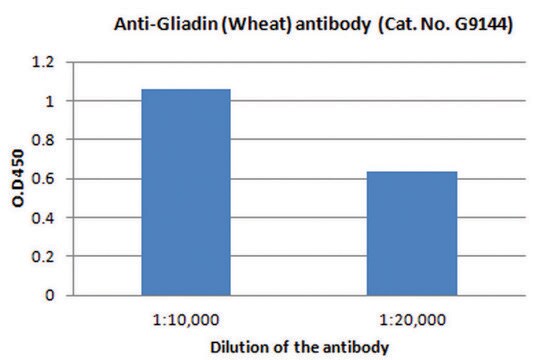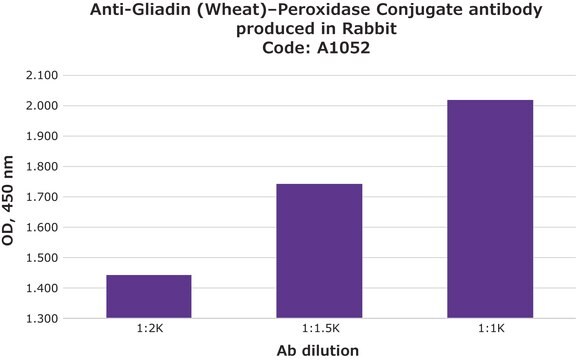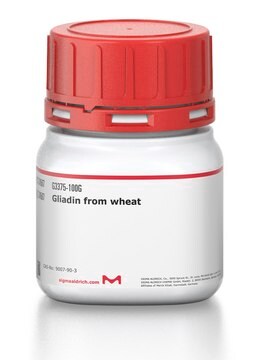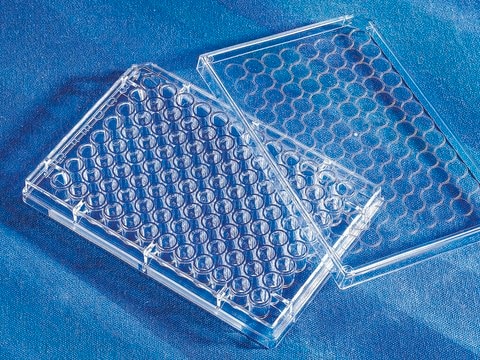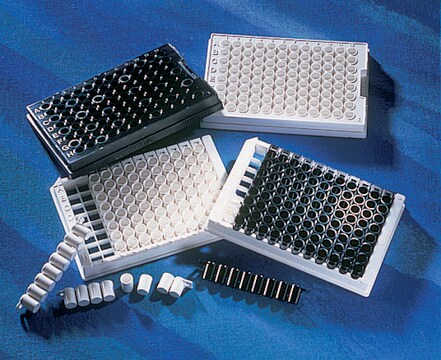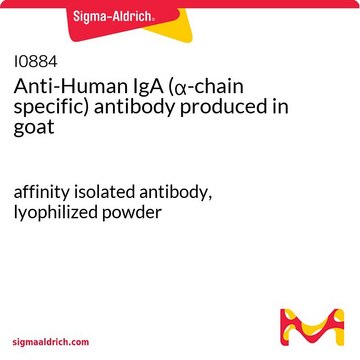SAB4200864
Anti-Gliadin antibody, Mouse monoclonal
clone GLD7, purified from hybridoma cell culture
Sinônimo(s):
Prolamin, alpha-gliadin
About This Item
Produtos recomendados
forma do anticorpo
purified from hybridoma cell culture
Nível de qualidade
clone
GLD7
reatividade de espécies
plant
concentração
~1 mg/mL
técnica(s)
ELISA: 0.12-0.06 μg/mL using wheat gliadin (Sigma #G3375)
immunoblotting: 1-2 μg/mL using wheat gliadin (Sigma #G3375)
Isotipo
IgG1
nº de adesão UniProt
Condições de expedição
dry ice
temperatura de armazenamento
−20°C
modificação pós-traducional do alvo
unmodified
Descrição geral
As plant proteins, they are recognized as prion-free 2.Gliadin can adhere to the mucus layer of the stomach due to its mucoadhesive property, which is a result of various interactions (e.g., hydrogen bonding, van der Waals force, and mechanical penetration).
Especificidade
Aplicação
Ações bioquímicas/fisiológicas
The tissue transglutaminase-catalyzed changes in gliadin are not restricted to single gliadin types, for example, prolamines in barley and rye (known as hordelin and secalin, respectively) and these may induce a messenger RNA-mediated interferon-gamma response in the small-intestinal mucosa of celiacs. An alpha-2-gliadin-33-mer appears to pass through the enterocyte brush border membrane by a dose-dependent translocation mechanism, and this is further enhanced by interferon-gamma, possibly mediated by a delayed epidermal growth factor endocytosis. In active celiac disease, this immune-mediated response is very complex and involves many different mediators (such as Interlukin-21 from activated CD4+ Tcells) some are still being studied.
With genetic susceptibility, gliadin may interact with interenterocyte tight junctions and cause their disassembly. Moreover, Gliadin peptides may bind to the chemokine receptor, CXCR3. This induces zonulin release from the tight junction region and causes a resultant increase in intestinal permeability. Permeability increases have also been demonstrated prior to the onset of clinically apparent celiac disease, and even with a gluten-free diet, this altered tight junction permeability may not completely return to normal3.Anti Gliadin antibody may serve as an important tool in Celiac disease research field.
forma física
Armazenamento e estabilidade
Exoneração de responsabilidade
Código de classe de armazenamento
12 - Non Combustible Liquids
Classe de risco de água (WGK)
nwg
Ponto de fulgor (°F)
Not applicable
Ponto de fulgor (°C)
Not applicable
Escolha uma das versões mais recentes:
Certificados de análise (COA)
It looks like we've run into a problem, but you can still download Certificates of Analysis from our Documentos section.
Se precisar de ajuda, entre em contato Atendimento ao cliente
Já possui este produto?
Encontre a documentação dos produtos que você adquiriu recentemente na biblioteca de documentos.
Global Trade Item Number
| SKU | GTIN |
|---|---|
| SAB4200864-100UL | |
| SAB4200864-25UL |
Nossa equipe de cientistas tem experiência em todas as áreas de pesquisa, incluindo Life Sciences, ciência de materiais, síntese química, cromatografia, química analítica e muitas outras.
Entre em contato com a assistência técnica